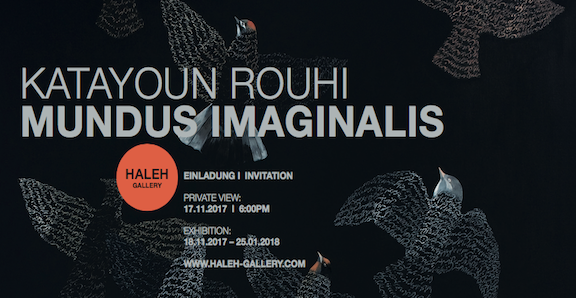MUNDUS IMAGINALIS

Haleh Gallery presents for the first time the artist Katâyoun Rouhi with her solo exhibition Mundus Imaginalis. The title Mundus Imaginalis refers to Henry Corbin (1903-1978), researcher and professor at the university Sorbonne in Paris. The Latin expression “Mundus Imaginalis” translates as imaginative world, a world of imagination, a world beyond rational understanding. Henry Corbin gained this insight because he focused in his research on the spiritual heritage of the Persian world. One cannot only find spirituality but also philosophical teaching in the Persian context. Especially in the literary traditions, for instance in the poetry of famous poets such Rumi (1207-1273) and Hafez (1315-1390). Poetry and literature are essential components of cultural heritage in Iran and also part of a living tradition. Editions of Hafez’s poem collections can be found in virtually all Iranian households. Reciting poems by heart is a common practice; for all sectors of the Iranian society. Remarkable tombs in the city of Shiraz, which are popular and highly frequented national sights are dedicated to the great poets Hafez and Saadi.
Persian poetry is also an important source of inspiration for visual arts. In the works of the artist Katâyoun Rouhi, who lives in Paris, poetry and painting merge into each other and become inseparable. Poetry is for Katâyoun Rouhi the invisible inner form of her creativity, taking its outer shape in paintings. Katâyoun Rouhis poems also address existential questions of life.
The solo exhibition MUNDUS IMAGINALIS by Katâyoun Rouhi focuses on two major series of her artistic work and also presents the eponymous installation “Mundus Imaginalis” consisting of Earth, shrub, and gold powder (2017).
1. Trees: The tree presents not only the life of a simple plant. It also symbolizes the connection between sky and earth, horizontality and verticality. The tree’s shape of verticality connects the invisible roots of the earth with the sky through the tree’s twigs and branches. The theme of the tree also alludes to questions of reality and visibility. What is visible in our perception? Even though the branched root system is beyond our visual perception, it is the actual powerhouse of the tree.
2. The series “Langage des Oiseaux” (Conference of the birds) is not only painted poetry, but deals also with spiritual themes. The conference of the birds dates back to a poem by the mystic Farid ud-din Attar (1136-1220) and is one of the most important pieces of Persian literature. The birds of the world come together to find a new king. According to the legend, the ideal king named Simorgh lives on the mountain Ghaf. The birds travel together to the mountain. Traveling is long and arduous. At the end of the travel only thirty birds remained. But at the destination of their trip, the birds do not find their king. All they can find is their own reflection in a mirror. Through the reflection the birds understand that they are the king themselves, they have been searching for. This becomes also clear through the Persian name Simorgh, which consists of “si” meaning thirty and “morgh” bird. Thus, Simorgh means thirty birds (king).
Katâyoun Rouhi refers in her series “Langage des Oiseaux” to the birds’ travel through the seven valleys, which they had to cross in order to reach Mount Ghaf. The seven valleys are:
Valley of quest, valley of love, valley of knowledge, valley of detachment, valley of uniqueness, valley of astonishment, and the valley of annihilation.
These valleys are not only important for Attar’s poem, but they are also essential allegories of Sufism. The valleys represent main stages on the spiritual path. The goal of the path is the annihilation of the self and the unification with the divine.
Attar’s mystic poem “Conference of the birds” is the textual content of Katâyoun Rouhi’s works. Rouhis artistic works create a magical interplay between text and image. The Persian script is not only represented as poems, but also becomes a visual mean creating the birds’ shapes. The tree is also in this series an important visual and textual element. The tree conjures up the imaginative world and the mount of Ghaf, where Simorgh is settled. The tree also refers to the poet Sohrab Sepehri. The very same tree is the only address, the only clue left by Sepehri to find the house of the friend.
Therefore, poetry, birds and trees complement each other in Rouhi’s works in a unique way. With her created pictorial worlds, Katâyoun Rouhi admits the viewer entry to the quoted Mundus Imaginalis. Rationality is not the appropriate remedy to experience this world, but it is Katâyoun Rouhi’s synthesis of poetry and image, making the imaginative world accessible and visible.
CV
Katâyoun Rouhi (*1965 in Iran) lives and works in Paris. Graduated in painting from École des Beaux Arts, Paris, Doctorate in aesthetics and art science Paris I, Panthéon-Sorbonne.
exhibitions (selection): Gerald Moor Gallery, London (2017); Ismaïli Center, London (2016); Shirin Art Gallery, Tehran, Iran (2015); MOP Fondation in Monaco “fundraising exhibition”, Monaco (2017); Museum of Contemporary Art, Ahvaz, Iran (2016); Contemporary Art Gallery, Auvers, France (2015); Internationale Auktion, Christie’s, Doha, Qatar (2011).
Collections: Polychronopoulos Foundation, Athens; The Méshkinfam Foundation & Museum, Shiraz.
« Back to exhibition overview